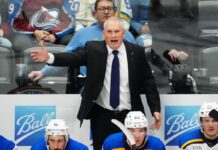
Ahead of the HNIC matchup against the Rangers, head coach Sheldon Keefe discussed re-uniting the Morgan Rielly – Ilya Lyubushkin pairing, the benefits of keeping TJ Brodie on the left side, the role of fighting the modern game, and Ryan Reaves’ contributions as a fighter and a player.
Morning Skate Update – Mar. 2
Per Sheldon Keefe:
🏒 Ilya Lyubushkin makes Leafs debut 2.0 tonight alongside Morgan Rielly
🏒 Timothy Liljegren is a game-time decision
🏒 Calle Jarnkrok will return to the lineup @TSN_Edge
— Mark Masters (@markhmasters) March 2, 2024
What did you like about how Morgan Rielly and Ilya Lyubushkin paired together back in the 2021-22 season?
Keefe: They just seemed to complement each other well.
Lyubushkin himself — at that time — brought a lot to our team in terms of physicality and competitiveness, making it hard to enter our zone and hard to be around our net. It was something that we really needed at that time. You still need it. We have improved in that area with our team mindset as well as some of our personnel — McCabe and Benoit — and Lyubushkin will add to that.
He seemed to complement Morgan well and bring out the best in him. Part of it is what Lyubushkin brings and part of it is how it impacts the rest of the group and enhances everybody else, especially when you couple that with Liljegren coming back. Now you get Rielly a partner he has played well with and it’s a good place to start with Lyubushkin coming in with some familiarity.
We get Brodie on the left side, too. Just that one move is able to snap some things into place for us. We like the look of it. We will monitor it.
What do you like more about TJ Brodie on the left?
Keefe: It improves his ability to see the ice and move the puck. You are defending less. You are getting the puck in the hands of their forwards better and quicker. That is what I have seen.
You get to see a lot more of the ice from that side and executing the passes is that much cleaner. Any time you are forced onto your backhand, it is really difficult to be on your backhand and survey the ice. Usually, when you are on your backhand, you are looking at the puck. When you are on your natural side, you are seeing the ice. You can just feel the puck and you don’t even have to look at it. The backhand complicates things quite a bit.
That is where I have seen the biggest improvement with Brodie being over there: one less thing for him to worry about and think about. He has managed that extremely well over his career, but that doesn’t mean it is not easier to be on the left. It certainly is.
Fighting has evolved a lot in the game since your playing days. Where does it fit into the modern game?
Keefe: Everybody would have a different opinion on that. I think it still has its place in the game. You are seeing a real evolution where it seems like the staged fighting off of the faceoffs is pretty much extinct. There has been a little bit of uptick in that recently, but it is pretty much instinct. It is now more reactionary where it is part of the game and something happens like a big hit. That seems to be where it has gone.
It is something that it seems like the fans are still entertained by — very much so. For players themselves, as they are coming up through juniors and into pro hockey, it is less a part of the culture and less a part of what they are taught or developed or what they latch onto as young players. Naturally, you see less and less of it as a result.
As a result, you get less fighting at all levels. That is kind of the way it goes, but as you saw the other night in our game, Reavo throws a big hit, it raises the game’s temperature, and there is a fight in response to that. It raises the game’s temperature, and to that degree, it has its place.
At the same time, I have a brother who had over 200 fights in his time through hockey. That is a tough thing to go through when you are watching. I certainly see the safety side of it.
How would you assess Reaves’ ability to read the situation and stir the pot at the right time?
Keefe: He is a pro. He has done it for a long time. He knows his spots. He is very comfortable with it.
For a guy like him, it gets to be harder to find fights. As you get older, you are not going looking for them as much, either. It is all a part of it.
I am sure I am getting these questions because the Rangers are coming in here. As much as I think it is a part of it, a lot of that stuff is sideshow stuff that really doesn’t have as much impact on the game as we think. It is more about the play on the ice.
I am watching this Rangers fourth line. These guys are coming in and doing a good job. They are not playing a lot, but they are forechecking well. They are all around the net. They are hard to handle once they get running around in the offensive zone. They are being effective in those ways.
Reavo has played some terrific hockey. The opposition has had a really hard time handling him when he is skating and playing the way he is, and the chemistry is developing here with Holmberg and Kampf. To me, that is more what it is about — how you can impact the game.
The threat of the physicality and the fighting is one thing that is out there, but when those players can play and impact the game, now you really have something.
In Reaves’ game, what has been the difference?
Keefe: I would say it is his skating and his work rate. His feet are constantly moving. He is a big, strong man. It is really hard to contain him.
He is a very smart player. Right from preseason, it was very obvious to me. He is a smart defensive player. He knows where to go. His stick is in good spots. He gets pucks out on the wall. He does little things well.
His rate of speed in which he can make a defensive play and get onto offense to help keep his line on offense, the way he can forecheck, and now also blend it with backchecking and killing plays in the neutral zone — all of that stuff has gone way up.
Some of it is probably a conditioning piece. He has done a lot of work. He has skated a lot. In the time he was out of the lineup, he worked a lot with our development people and was focused on himself and his game.
I am sure part of it is a mindset, too. He doesn’t want to come out of the lineup. No player would probably want to admit that, but I have said it before — and it is a dangerous thing for a player, but as a coach, you recognize it — that a lot of the guys who have been out of the lineup have come back in as better versions of themselves.
Whether it has been Robertson, Reaves, Kampf, Holmberg, or McMann, all the way through, our guys who have come out a little bit and have had to come back in have come in with a renewed mindset and have been really good. Reaves is certainly one.





























![New Leaf Anthony Stolarz on the opportunity in Toronto: “In Florida, I knew my role as a backup… Now, [Joseph Woll] and I are competing for starts… As a goalie, that’s all you can ask for” Anthony Stolarz, Stanley Cup win, now Maple Leaf](https://mapleleafshotstove.com/wp-content/uploads/2024/07/anthony-stolarz-sc-100x70.jpg)
